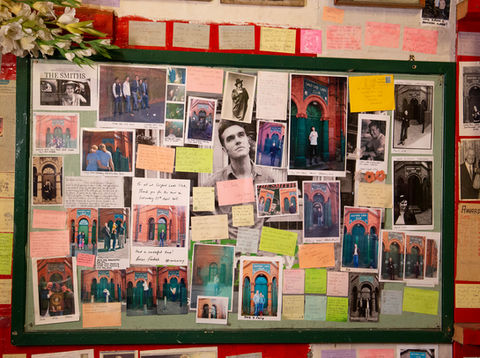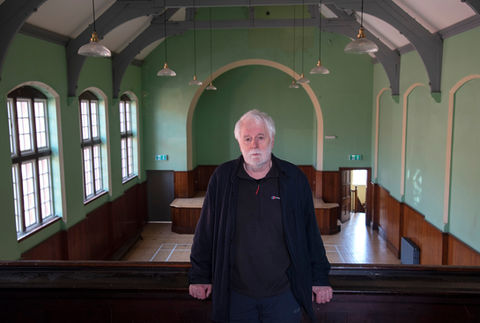
Photography by Matthew Hoing
Leslie Holmes is Project Manager and custodian of the iconic Salford Lads Club (SLC). Leslie is the driving force behind SLC’s restoration and redevelopment into was is now today one of the region’s most visited cultural sites. Artist Leslie has lived in Ordsall for over 30 years recording the changing inner city landscape of Salford and Manchester. He has created projects, with schools and community groups, looking at the past and present. He was lead artist at Ordsall Community Arts from 1996 until 2016. Leslie created projects about the Ordsall Estate for the Arts Council Architecture Week from 2002 to 2007 and developed projects for architecture students from Manchester University. Leslie was also commissioned by the Chapman Gallery in 2010 to work on “Salford in Motion” about the changing views of Salford.
Salford Lads Club was established in 1903 as a purpose built club for boys. The club has continued to provide this facility for more than 100 years and is now considered to be the ‘finest example of a pre First World War club surviving and operating today’. The club is now open to girls and boys. SLC was part of the wider movement of lads clubs, whose aim was to provide positive alternatives to the teenage street gangs of the time (known as “scuttlers”) with sports, arts, cultural and educational activities. The club was officially opened in 1904 by Robert Baden-Powell.
Salford Lads Club - History

Salford Lads Club


Salford Lads Club's iconic sign

Salford Lads Club's gym hall
The club is also known for a famous photo taken by Stephen Wright in 1985, of The Smiths outside the building with the iconic sign in the background. Morrissey was a fan of Salford-born playwright Shelagh Delaney and the image ended up used in the inside album sleeve of The Smith’s third album ‘The Queen is Dead’. The band still have cult following with fans making the pilgrimage from around the world to visit the club and the dedicated Smiths Room, an ongoing installation created and curated by Leslie Holmes where they can share their own photo snapped outside the club.

The Smiths Room
Q & A with Leslie Holmes
Q: Where and when were you born?
A: I’m from Sowerby Bridge in West Yorkshire born in 1950
Q: When and why did you move to Manchester/Salford?
A: I moved to Salford in1991 after working in art colleges, schools and youth clubs. I’d had exhibitions of my work, but I wanted to spend more time making art, and moving to the city gave me that opportunity. I started with a small studio unit at New Mount Street and I’m now in my 6th studio space as every building I was in has been redeveloped: it’s a symbol of the city. I got involved in the local community with Ordsall Community Arts and I worked with them for over 20 years creating projects across the city with a huge range of community groups. I came across Salford Lads Club in 2001 when I was looking for a space to work with three school groups, looking at family links with the remaining original buildings of the “Docks Estate” The Ordsall estate had gone through enormous changes from the late 1960s onwards, with the closure of Salford Docks and the loss of over 7000 terraced houses; Salford Lads Club is one of the few buildings where generations of people still have a link.

Q: Why is Salford Lads Club so important to the city and its community?

A: Looking across the city in 2024 with all the new developments, I’m aware that this has been at the expense of much of the working class identity the city is founded on; not only the loss of industrial buildings, but the streets, pubs, shops and clubs that were the heart of community life. Salford Lads Club and the surrounding streets are an exception to this pattern of change, and the club is still an important centre 120 years after it first opened.
Q: What facilities do the club offer to the community?
A: The club continues to provide activities for local young people with over 250 children attending sessions in sports and arts each week, many of these have family links with the club across 3 generations. The building is grade II listed, described as the last remaining pre-WWI working lads club still in use. The building has a concert hall and band room, sports gym, boxing gyms and games room, which are still used every week by young people and local adults. Some of the older volunteers originally came here as young boys, and they not only still work with young people but they also show visitors around the club during two open days each week, telling their own stories about Salford Lads Club.

One of the first projects Leslie created at Salford Lads Club in 2003. A giant map of the Ordsall Estate painted directly on to the gym floor

Leslie (centre) with the Duke of Kent, 2004
Q: Is it important that Salford Lads Clubs continues to be faithful to its working class roots?
A: The club has retained records dating back to the first opening in 1903, along with holding over 22,000 membership cards. In 2015, design company “Why Not Associates” created a 5-metre-long wall displaying all these names, which is now on permanently display in our archive room.
Along with its continuing working class story, the club is a growing pilgrimage site for music fans from around the world who want to pose outside the famous sign, photographed for the Smiths album “The Queen is Dead” by Stephen Wright in 1985. In 2004 the club opened a Smiths Room where I have displayed and continue to curate an installation of photographs and messages sent in by fans, in what was an old and unused weightlifting room. The club is now the 3rd most visited music tourism site in the UK.
THE SHOOT: Salford Lads Club, Coronation Street, Salford
Related links:
Student reflection: Matthew Hoing

I found my shoot with Leslie Holmes at the Salford Lads Club to be both engaging and rewarding. Leading up to the shoot itself I was certainly nervous but not worried, it was more excitement to meet Leslie and see the club.
We met Leslie at the entrance to the club and spent the first 20 mins learning about SLC’s rich history. At the start of the shoot there were some technical issues with the original camera I was using, to maintain a sense of professionalism I swapped cameras to avoid holding up the shoot. I photographed Leslie in a number of different locations around the building, these included the archive room, the boxing gym, the concert hall and the amazing Smiths Room. Leslie was happy to pose and was easy to work with. We completed the shoot outside the building focusing on the iconic SLC doorway and sign. This is where I knew I would get one of my key images. I’m happy to say I managed to achieve this.
I believe my final images successfully capture the close relationship between Leslie and the magnificent building. The whole experience certainly took me out of my comfort zone and challenged my communication skills. It was a pleasure to meet and work with Leslie and to learn about one of the region’s most iconic buildings.















